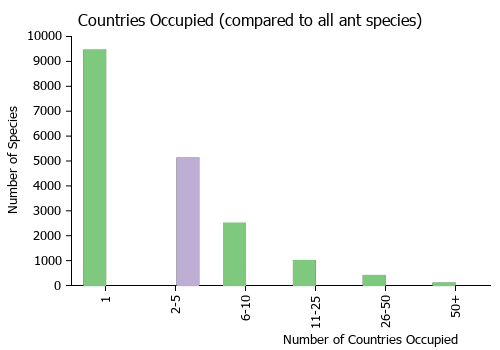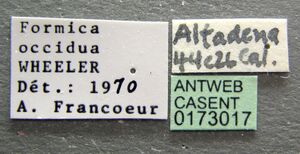Formica moki
| Formica moki | |
|---|---|

| |
| Scientific classification | |
| Kingdom: | Animalia |
| Phylum: | Arthropoda |
| Class: | Insecta |
| Order: | Hymenoptera |
| Family: | Formicidae |
| Subfamily: | Formicinae |
| Tribe: | Formicini |
| Genus: | Formica |
| Species: | F. moki |
| Binomial name | |
| Formica moki Wheeler, W.M., 1906 | |
| Synonyms | |
| |
Usually nests under stones in open woods; sometimes under sidewalks or along the sides of buildings. May become a pest by foraging in houses or by tending aphids on cultivated plants. Fierce and aggressive.
Identification
Keys including this Species
Distribution
Northwestern comer of Arizona, southern Nevada, California north to Oregon, and south to Mexico.
Latitudinal Distribution Pattern
Latitudinal Range: 42.81666667° to 19.27649°.
| North Temperate |
North Subtropical |
Tropical | South Subtropical |
South Temperate |
- Source: AntMaps
Distribution based on Regional Taxon Lists
Nearctic Region: United States (type locality).
Neotropical Region: Mexico.
Distribution based on AntMaps
Distribution based on AntWeb specimens
Check data from AntWeb
Countries Occupied
| Number of countries occupied by this species based on AntWiki Regional Taxon Lists. In general, fewer countries occupied indicates a narrower range, while more countries indicates a more widespread species. |

|
Estimated Abundance
| Relative abundance based on number of AntMaps records per species (this species within the purple bar). Fewer records (to the left) indicates a less abundant/encountered species while more records (to the right) indicates more abundant/encountered species. |

|
Biology
Nevada, Wheeler and Wheeler (1986) - Our 8 records from 5 localities are all from the southern part of the state and all in the Pinyon-Juniper Biome. One nest was in the ends of a rotten log (8 cm in diameter) lying on the ground, 3 were under stones, and I was in the slightly decayed buried portion of a log 15 cm in diameter. We noted that the workers were fast and aggressive, that the bite was annoying and that a populous colony produced an invisible cloud of formic acid over a disturbed nest.
Association with Other Organisms
 Explore: Show all Associate data or Search these data. See also a list of all data tables or learn how data is managed.
Explore: Show all Associate data or Search these data. See also a list of all data tables or learn how data is managed.
Other Ants
Nests of this species occasionally host Temnothorax andrei, although the nature of the relationship is unknown (Mann, 1911).
This species is a host for the ant Polyergus vinosus (a slave maker) (Trager, 2013; de la Mora et al., 2021).
Flight Period
| X | X | ||||||||||
| Jan | Feb | Mar | Apr | May | Jun | Jul | Aug | Sep | Oct | Nov | Dec |
Source: antkeeping.info.
- Check details at Worldwide Ant Nuptial Flights Data, AntNupTracker and AntKeeping.
- Explore: Show all Flight Month data or Search these data. See also a list of all data tables or learn how data is managed.
Castes
Worker
   
| |
| Worker. . | Owned by Museum of Comparative Zoology. |
   
| |
| Worker. . | Owned by Museum of Comparative Zoology. |
Images from AntWeb
   
| |
| Paratype of Formica moki. Worker. Specimen code casent0173015. Photographer April Nobile, uploaded by California Academy of Sciences. | Owned by MCZ, Cambridge, MA, USA. |
   
| |
| Worker. Specimen code casent0173016. Photographer April Nobile, uploaded by California Academy of Sciences. | Owned by MCZ, Cambridge, MA, USA. |
   
| |
| Worker. Specimen code casent0173017. Photographer April Nobile, uploaded by California Academy of Sciences. | Owned by MCZ, Cambridge, MA, USA. |
Nomenclature
The following information is derived from Barry Bolton's Online Catalogue of the Ants of the World.
- moki. Formica moki Wheeler, W.M. 1906d: 343 (w.) U.S.A. Cole, 1966: 25 (m.). Combination in F. (Neoformica): Wheeler, W.M. 1913f: 558. Junior synonym of occidua: Francoeur, 1973: 254. [Note that moki has seniority over occidua and hence is the valid name; see Smith, D.R. 1979: 1453.] See also: Smith, M.R. 1939f: 582.
- occidua. Formica rufibarbis var. occidua Wheeler, W.M. 1913f: 517 (w.q.) U.S.A. [F. rufibarbis var. occidua Wheeler, W.M. 1912c: 90. Nomen nudum.] Subspecies of rufibarbis: Creighton, 1950a: 539. Raised to species and stated as senior synonym of moki: Francoeur, 1973: 254 [the latter has priority and hence is the valid name: Smith, D.R. 1979: 1453].
Unless otherwise noted the text for the remainder of this section is reported from the publication that includes the original description.
Description
References
- Alatorre-Bracamontes, C.E., Vásquez-Bolaños, M. 2010. Lista comentada de las hormigas (Hymenoptera: Formicidae) del norte de México. Dugesiana 17(1): 9-36.
- Blaimer, B.B., Ward, P.S., Schultz, T.R., Fisher, B.L., Brady, S.G. 2018. Paleotropical diversification dominates the evolution of the hyperdiverse ant tribe Crematogastrini (Hymenoptera: Formicidae). Insect Systematics and Diversity 2(5): 3; 1-14 (doi:10.1093/isd/ixy013).
- Booher, D.B. 2021. The ant genus Strumigenys Smith, 1860 (Hymenoptera: Formicidae) in western North America north of Mexico. Zootaxa 5061, 201–248 (doi:10.11646/zootaxa.5061.2.1).
- Borowiec, M.L., Cover, S.P., Rabeling, C. 2021. The evolution of social parasitism in Formica ants revealed by a global phylogeny. Proceedings of the National Academy of Sciences 118, e2026029118 (doi:10.1073/pnas.2026029118).
- Cole, A. C., Jr. 1966b. Ants of the Nevada Test Site. Brigham Young Univ. Sci. Bull. Biol. Ser. 7(3 3: 1-27 (page 25, male described)
- de la Mora, A., Sankovitz, M., Purcell, J. 2020. Ants (Hymenoptera: Formicidae) as host and intruder: recent advances and future directions in the study of exploitative strategies. Myrmecological News 30: 53-71 (doi:10.25849/MYRMECOL.NEWS_030:053).
- Francoeur, A. 1973. Révision taxonomique des espèces néarctiques du groupe fusca, genre Formica (Formicidae, Hymenoptera). Mém. Soc. Entomol. Qué. 3: 1-316 (page 254, Junior synonym of occidua)
- Jansen, G., Savolainen, R. 2010. Molecular phylogeny of the ant tribe Myrmicini (Hymenoptera: Formicidae). Zoological Journal of the Linnean Society 160(3), 482–495 (doi:10.1111/j.1096-3642.2009.00604.x).
- Smith, M. R. 1939f. Notes on Formica (Neoformica) moki Wheeler, with description of a new subspecies (Hymenoptera: Formicidae). Ann. Entomol. Soc. Am. 32: 581-584.
- Wheeler, G. C. and J. Wheeler. 1986. The ants of Nevada. Natural History Museum of Los Angeles County, Los Angeles.
- Wheeler, W. M. 1906i. The ants of the Grand Cañon. Bull. Am. Mus. Nat. Hist. 22: 329-345 (page 343, worker described)
- Wheeler, W. M. 1913i. A revision of the ants of the genus Formica (Linné) Mayr. Bulletin of the Museum of Comparative Zoology 53: 379-565 (page 558, Combination in F. (Neoformica))
References based on Global Ant Biodiversity Informatics
- Boulton A. M., Davies K. F. and Ward P. S. 2005. Species richness, abundance, and composition of ground-dwelling ants in northern California grasslands: role of plants, soil, and grazing. Environmental Entomology 34: 96-104
- Cole A. C., Jr. 1942. The ants of Utah. American Midland Naturalist 28: 358-388.
- Cover S. P., and R. A. Johnson. 20011. Checklist of Arizona Ants. Downloaded on January 7th at http://www.asu.edu/clas/sirgtools/AZants-2011%20updatev2.pdf
- Dattilo W. et al. 2019. MEXICO ANTS: incidence and abundance along the Nearctic-Neotropical interface. Ecology https://doi.org/10.1002/ecy.2944
- Des Lauriers J., and D. Ikeda. 2017. The ants (Hymenoptera: Formicidae) of the San Gabriel Mountains of Southern California, USA with an annotated list. In: Reynolds R. E. (Ed.) Desert Studies Symposium. California State University Desert Studies Consortium, 342 pp. Pages 264-277.
- Fisher B. L. 1997. A comparison of ant assemblages (Hymenoptera, Formicidae) on serpentine and non-serpentine soils in northern California. Insectes Sociaux 44: 23-33
- Francoeur A., and R. R. Snelling. 1979. Notes for a revision of the ant genus Formica. 2. Reidentifications for some specimens from the T. W. Cook collection and new distribution data (Hymenoptera: Formicidae). Contr. Sci. (Los Angel.) 309: 1-7.
- Francoeur. A. 1973. Revision taxonomique des especes nearctiques du group fusca, genre Formica. Memoires de la Societe Entomologique du Quebec 3: 1-316.
- Holway D.A. 1998. Effect of Argentine ant invasions on ground-dwelling arthropods in northern California riparian woodlands. Oecologia. 116: 252-258
- Johnson R. Personnal Database. Accessed on February 5th 2014 at http://www.asu.edu/clas/sirgtools/resources.htm
- Johnson, R.A. and P.S. Ward. 2002. Biogeography and endemism of ants (Hymenoptera: Formicidae) in Baja California, Mexico: a first overview. Journal of Biogeography 29:10091026/
- La Rivers I. 1968. A first listing of the ants of Nevada. Biological Society of Nevada, Occasional Papers 17: 1-12.
- Longino, J.T. 2010. Personal Communication. Longino Collection Database
- Mallis A. 1941. A list of the ants of California with notes on their habits and distribution. Bulletin of the Southern California Academy of Sciences 40: 61-100.
- Matsuda T., G. Turschak, C. Brehme, C. Rochester, M. Mitrovich, and R. Fisher. 2011. Effects of Large-Scale Wildfires on Ground Foraging Ants (Hymenoptera: Formicidae) in Southern California. Environmental Entomology 40(2): 204-216.
- Ratchford, J.S., S.E. Wittman, E.S. Jules, A.M. Ellison, N.J. Gotelli and N.J. Sanders. 2005. The effects of fire, local environment and time on ant assemblages in fens and forests. Diversity and Distributions 11:487-497.
- Reddell J. R., and J. C. Cokendolpher. 2001. Ants (Hymenoptera: Formicidae) from caves of Belize, Mexico, and California and Texas (U.S.A.) Texas. Texas Memorial Museum Speleological Monographs 5: 129-154.
- Vásquez-Bolaños M. 2011. Lista de especies de hormigas (Hymenoptera: Formicidae) para México. Dugesiana 18: 95-133
- Ward P. S. 1987. Distribution of the introduced Argentine ant (Iridomyrmex humilis) in natural habitats of the lower Sacramento Valley and its effects on the indigenous ant fauna. Hilgardia 55: 1-16
- Wetterer, J. K.; Ward, P. S.; Wetterer, A. L.; Longino, J. T.; Trager, J. C.; Miller, S. E. 2000. Ants (Hymenoptera: Formicidae) of Santa Cruz Island, California. Bulletin of the Southern California Academy of Sciences 99:25-31.
- Wetterer, J.K., P.S. Ward, A.L. Wetterer, J.T. Longino, J.C. Trager and S.E. Miller. 2000. Ants (Hymenoptera:Formicidae) of Santa Cruz Island, California. Bulletin of the Southern California Academy of Science 99(1):25-31.
- Wheeler G. C., and J. Wheeler. 1986. The ants of Nevada. Los Angeles: Natural History Museum of Los Angeles County, vii + 138 pp.
- Wheeler W. M. 1913. A revision of the ants of the genus Formica (Linné) Mayr. Bulletin of the Museum of Comparative Zoology 53: 379-565.
- Wheeler W. M. 1917. The mountain ants of western North America. Proceedings of the American Academy of Arts and Sciences 52: 457-569.
- Wittman S. E., N. J. Sanders, A. M. Ellison, E. S. Jules, J. S. Ratchford, and N. J. Gotelli. Forthcoming. Species interactions and thermal constraints on ant community structure. Oikos 119.
- Pages using DynamicPageList3 parser function
- North temperate
- North subtropical
- Tropical
- Ant Associate
- Host of Temnothorax andrei
- Host of Polyergus vinosus
- FlightMonth
- Species
- Extant species
- Formicidae
- Formicinae
- Formicini
- Formica
- Formica moki
- Formicinae species
- Formicini species
- Formica species
- Need Body Text
- Fusca group


